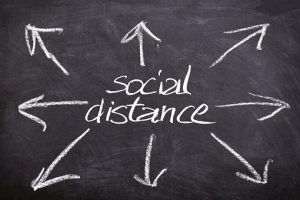Written by Joyce Smith, BS. This modelling study explores the impact of physical distancing measures on the progression of the COVID-19 pandemic that originated in Wuhan, China in December of 2019.
 An outbreak of a new acute respiratory syndrome coronavirus known as SARS-CoV-2, and later referred to as COVID-19, occurred in Wuhan, China in early December of 2019 1,2. The government instigated rapid screening measures, and imposed travel restrictions and physical distancing to curtail the viral spread. Schools and workplaces, which were already closed in mid-January for the Lunar New Year holidays (January 24th to January 30th), were extended into February and strict distancing measur es were implemented 3.
An outbreak of a new acute respiratory syndrome coronavirus known as SARS-CoV-2, and later referred to as COVID-19, occurred in Wuhan, China in early December of 2019 1,2. The government instigated rapid screening measures, and imposed travel restrictions and physical distancing to curtail the viral spread. Schools and workplaces, which were already closed in mid-January for the Lunar New Year holidays (January 24th to January 30th), were extended into February and strict distancing measur es were implemented 3.
Researchers Prem and colleagues 4 hoped to estimate the effects of the physical distancing measures on the progression of the COVID-19 epidemic, and to share the knowledge with the rest of the world. To that end, they developed a transmission model to quantify the impact of school and workplace closures by comparing data from several physical distancing scenarios: a scenario that included a hypothetical situation of no intervention measures and no holidays; a second scenario that assumed no implementation of physical distancing measures, but included the winter school break and Lunar New Year holidays as normal interventions in Wuhan; the third scenario that was based on intense control measures. They also factored into their model the effect of lifting imposed control measures by allowing people to return to work in a staggered fashion, as well as the effect of returning to work at different time points (March and April) of the epidemic spread.
The team found that physical distancing measures were most effective if the return to work was staggered and began at the beginning of April of 2020, thus potentially reducing the median number of new infections by more than 92% (IQR 66–97) in June and by 24% (13–90) at the end of the year 2020. If these restrictions were lifted in March, a second peak of cases might occur in late August. However, if these physical distancing measures could be sustained through April (just one month later), such a peak could be delayed until October (two months later thus giving health-care systems more time to prepare.
The results of this study suggest that acting promptly to close schools and workplaces in Wuhan, China not only reduced the number of COVID-19 cases, but also delayed the epidemic peak considerably, thus giving the Chinese health system more time to expand and to respond more effectively. Prem and colleagues recommend that all countries develop their own specific COVID-19 model that would include immediate testing, contract tracing, and quarantining all potential cases at the beginning of an epidemic as an alternative to distancing people through lockdown measures during an epidemic. They also suggest that if lockdown is done, it is important to gradually relax the lockdown measures to delay the development of a secondary peak and to prevent overwhelming health care systems as the epidemic gains traction.
Source: Prem, Kiesha, Yang Liu, Timothy W. Russell, Adam J. Kucharski, Rosalind M. Eggo, Nicholas Davies, Stefan Flasche et al. “The effect of control strategies to reduce social mixing on outcomes of the COVID-19 epidemic in Wuhan, China: a modelling study.” The Lancet Public Health (2020).
© 2020 The Author(s). Published by Elsevier Ltd. This is an Open Access article under the CC BY 4.0 license.
Click here to read the full text study.
Posted April 21, 2020.
Joyce Smith, BS, is a degreed laboratory technologist. She received her bachelor of arts with a major in Chemistry and a minor in Biology from the University of Saskatchewan and her internship through the University of Saskatchewan College of Medicine and the Royal University Hospital in Saskatoon, Saskatchewan. She currently resides in Bloomingdale, IL.
References:
- Li Q, Guan X, Wu P, et al. Early Transmission Dynamics in Wuhan, China, of Novel Coronavirus-Infected Pneumonia. The New England journal of medicine. 2020;382(13):1199-1207.
- Zhu N, Zhang D, Wang W, et al. A Novel Coronavirus from Patients with Pneumonia in China, 2019. The New England journal of medicine. 2020;382(8):727-733.
- Chen S, Yang J, Yang W, Wang C, Bärnighausen T. COVID-19 control in China during mass population movements at New Year. Lancet. 2020;395(10226):764-766.
- Fong MW, Gao H, Wong JY, et al. Nonpharmaceutical Measures for Pandemic Influenza in Nonhealthcare Settings-Social Distancing Measures. Emerg Infect Dis. 2020;26(5).
